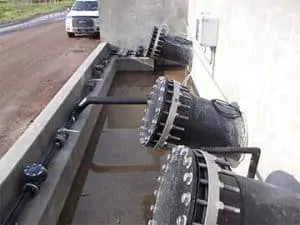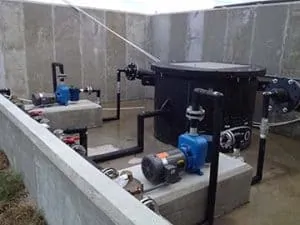

An SCS Advice from the Field blog.
Self-priming pumps can provide excellent performance in the design of a landfill leachate removal system. Landfill owners and operators prefer them to help control construction and maintenance costs too.
A typical system for removing leachate from landfill disposal cells is to have a collection point (sump) inside the lined area of the disposal cell at the toe of the landfill perimeter berm slope with large riser pipes extended from the top of the berm to the bottom of the sump. Removal of leachate from the sump takes place by placing specialized submersible pumps inside the large riser pipes with electric controls for ON-OFF switches inside the control panel of the pumps located at the top of the landfill perimeter berm. The pumps are equipped with wheels that roll down the riser pipe and are positioned in the horizontal portion of the riser pipe at the bottom of the sump. The discharge line from the pump extends up through the riser pipe, and after exiting the riser pipe at the top of the berm, connects to a leachate force main in the perimeter berm. Leachate in the sump flows into the riser pipe through perforations in the riser pipe and reaches the intake of the submersible pump for removal from the sump.
Maintenance of such submersible pumps is not easy; the entire pump assembly including the power cable connected to the pump, level control leads, discharge line, and the pump is taken out of the riser pipe to have access to the pump. Normally, the entire pump assembly is soiled with leachate and slime sticking to the pipes, lines, and the pump while submerged in leachate. The discharge line could be a 2-inch diameter solid HDPE pipe long enough to reach the sump bottom from the top of the perimeter berm. Depending on the depth of the landfill from the top of the perimeter berm, the discharge lines could be long; which means the technician has to handle the extraction of a long and heavy pipe connected to a heavy pump at the lower end of the pipe, out of the rise pipe. Technicians handling the maintenance of the submersible leachate pumps must be well trained about safety aspects of the activities involved in the maintenance of such pumps. The structure located at the top of the berm, where the riser pipes and leachate piping are located, should be watertight to prevent liquids generated during maintenance activities from escaping into the berm structure and entering the environment. It is a safe practice to have more than one technician attempting to remove a submersible pump for maintenance purposes.

For landfills with depth to the bottom of the disposal cell less than the water column vacuum pressure (for practical purposes less than 15 ft.), self-priming pumps may be a feasible replacement for specialized submersible pumps. Self-priming pumps are not specialized pumps, come in all sizes, are much less expensive than the submersible pumps, and can easily be installed inside the structure at the top of the perimeter berm with a 2-inch line extended to the bottom of the riser pipe for leachate removal. Maintenance of such pumps is significantly less cumbersome than submersible pumps, with one technician able to handle replacement or maintenance of the pump in a much shorter period than that of a submersible pump. The work is not necessarily a dirty job where the technician has to handle a significant amount of leachate and slime. For maintenance of the pump, the 2-inch diameter pipe inside the riser pipe for removal of leachate does not need to be extracted. The self-priming pumps are normally designed to prime easily after each maintenance session. A check valve on the intake of the pump and a check valve near the bottom of the removal pipe prevents the liquid inside the pump and the removal pipe from flowing back down to the sump when the pump goes OFF, which prevents the need for priming the pump on the next ON cycle. The leachate level control can be a bubbler system installed inside the pump control panel with the air hosing extended to the bottom of the riser pipe. The initial setting of the bubbler system allows to control ON and OFF levels of the pump.

Self-priming pumps could also be used for double lining systems equipped with a secondary sump and a primary sump. A secondary pump removes liquids from the secondary sump and a primary pump removes leachate from the primary sump. In areas where freezing conditions during the wintertime are expected, self-priming pumps can also be used as long as the pumps and exposed piping are located inside an enclosed housing to prevent frost.

Liquids Management and Landfill Design